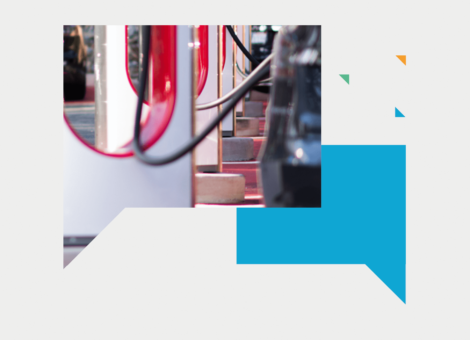The evolution of EV technology and impact on fuel retailing
At our Fuel and Convenience Innovation Summit, we looked at developments within the industry which provide retailers with opportunities to expand and enhance their offering. One area of focus was Electric Vehicles (EVs). EVs have become an increasingly popular alternative to internal combustion engines (ICEs), and are set to prosper further as global markets recover from COVID-19.
Embracing the EV market by adapting your offer ahead of the curve will build brand recognition and customer loyalty for proactive competitive advantage. So, how is the EV market evolving, and what first steps can retailers take to adapt with it?
The evolution of EVs
Electric vehicles have existed longer than many realize — as far back as 1900 — with concept cars being developed concurrently with the exploration of alternative fuels, during the latter half of the 20th century. Back in the 1990s, several automotive brands developed EVs but saw very low adoption rates. Over the last 20 years, however, they’ve grown from an emerging trend to the obvious choice for modern motorists.
Indeed, EVs are now an ecological, technological, and economic imperative. Aligning with the global incentive to reduce environmental impact, price economics and parity with ICE, rapidly changing infrastructure, and government incentives, 13 countries and 31 cities have already announced plans to phase out internal combustion vehicles by 2040 or sooner.
Environmental concerns have only been reinvigorated during the pandemic, and EV sales are predicted to recover faster than their ICE counterparts, with lower pollution and cleaner air encouraging environmentally conscious consumers to switch. BloombergNEF’s 2020 EVO Report forecasts 54m EVs being sold annually — 58% of all car sales — by 2040. BloombergNEF further projects EVs to hold 31% market share of the total global passenger vehicle fleet by this time.
This is supported by an ever-expanding EV fleet that offers greater consumer choice, as manufacturers continue to extend their target audiences. It’s estimated there’ll be over 500 EV models by 2022. Tesla recently announced plans to release a more affordable $25,000 model, broadening its audience considerably.
What does this mean for retailers?
The EV market isn’t currently upsetting oil or energy demand. Although BloombergNEF estimates “EVs across all segments are already displacing 1 million barrels of oil demand per day”, out of 14 million barrels from all types of road transport, the impact is currently fairly small. However, the market’s growth is expected to have a greater impact in the near future. A 2018 Accenture Fuel Retail survey found the rise in EV usage was seen as the biggest disruptor of demand in the next three-to-five years by fuel retailers.
Changing consumer technology preferences are laying the groundwork for mass adoption. While it’s likely to be at least a decade before EVs are commonplace, it puts pressure on fuel retailers to cater for EV customers in advance.
First steps for retailers
The charger installation process is becoming more accessible and affordable. Governments in many markets are offering purchase subsidies to encourage installation, so check what incentives are available to you. EVC providers typically self-fund, unless your site is particularly remote. Despite this accessibility, it’s important to realize this is a long-term business case with return of investment beyond five-to-ten years.
However, this can be offset by the benefits of EV customers spending longer in store — where margins are higher — while they wait.
Charger manufacturers that approach retailers to suggest installation will have typically already assessed your location(s) before they make contact with you. If you’re approaching them, your business case should include robust data around traffic flows, demand profiles, and how your customers’ demographic profile aligns with the typical EV consumer. Kalibrate can help you build this business case. We can analyze demographic profiles, and mobility patterns, helping you predict demand growth and formulate the optimal strategy to integrate EVs into your offer.
The market is especially appealing now as competition for volume based on price isn’t a factor – It’s currently cheaper to charge an EV than fill up an ICE. Since convenience is the consumer priority, we’re nowhere near the price sensitivity of fuel yet — consumers will pay what’s offered, especially on longer routes. You should therefore set a strategy related to your brand, rather than against competition.
Typically, charger providers will establish and control the pricing structures based on combinations of time, charge volume, and membership, but more retailers are taking ownership of the price-setting process. You can harness Kalibrate’s expertise in pricing strategy development to understand how to adapt to the evolving EV market and optimize your offer with EV business.
—
To find out how to attract EV business with the right offer on-site, using your understanding of the EV market and consumer preferences, read our second blog on the evolution of EV — the evolved consumer.
Read more articles about:
Electric VehiclesSubscribe and get the latest updates
You may unsubscribe from our mailing list at any time. To understand how and why we process your data, please see our Privacy & Cookies Policy
Related Resources
Electric Vehicles
How can fuel retailers appeal to the evolved EV consumer?
Anila Siraj, Head of Data Strategy outlines why fuel retailers need to embrace the growing electric vehicle (EV)...

Electric Vehicles
Together in electric dreams: part one
The global electric vehicle (EV) market is growing at an incredible pace.


